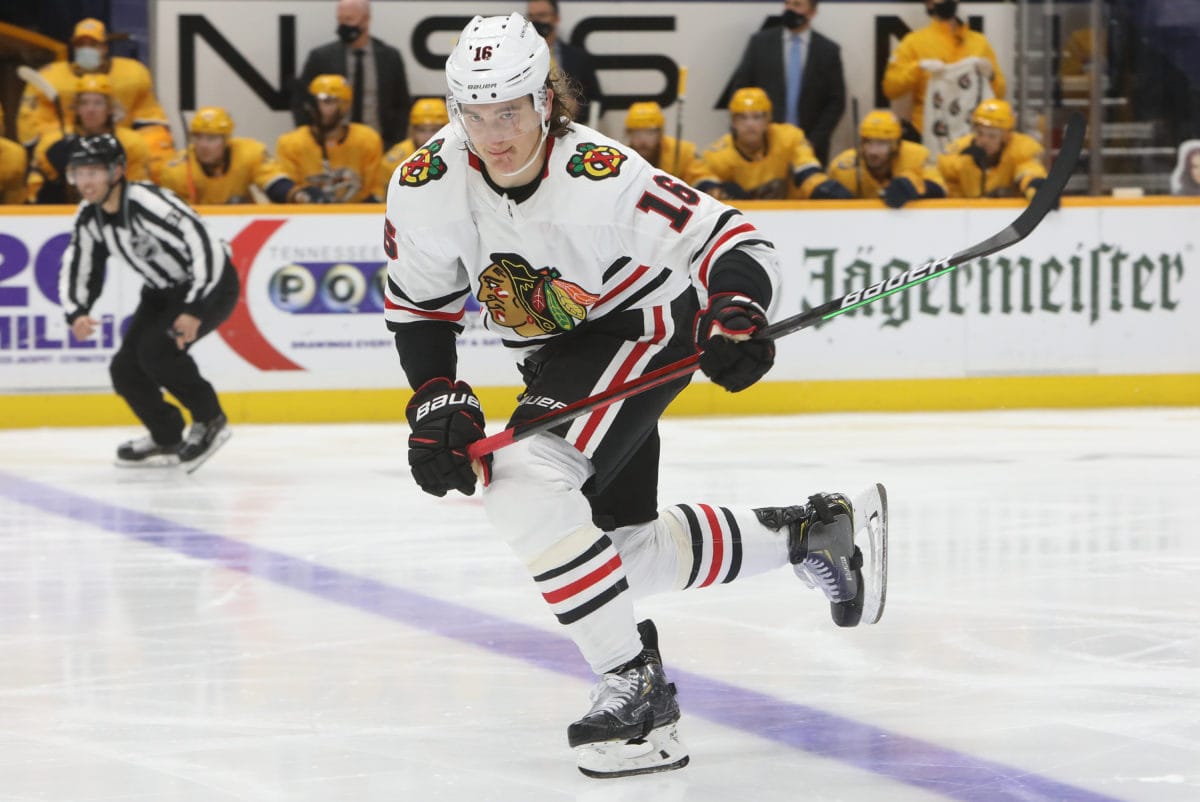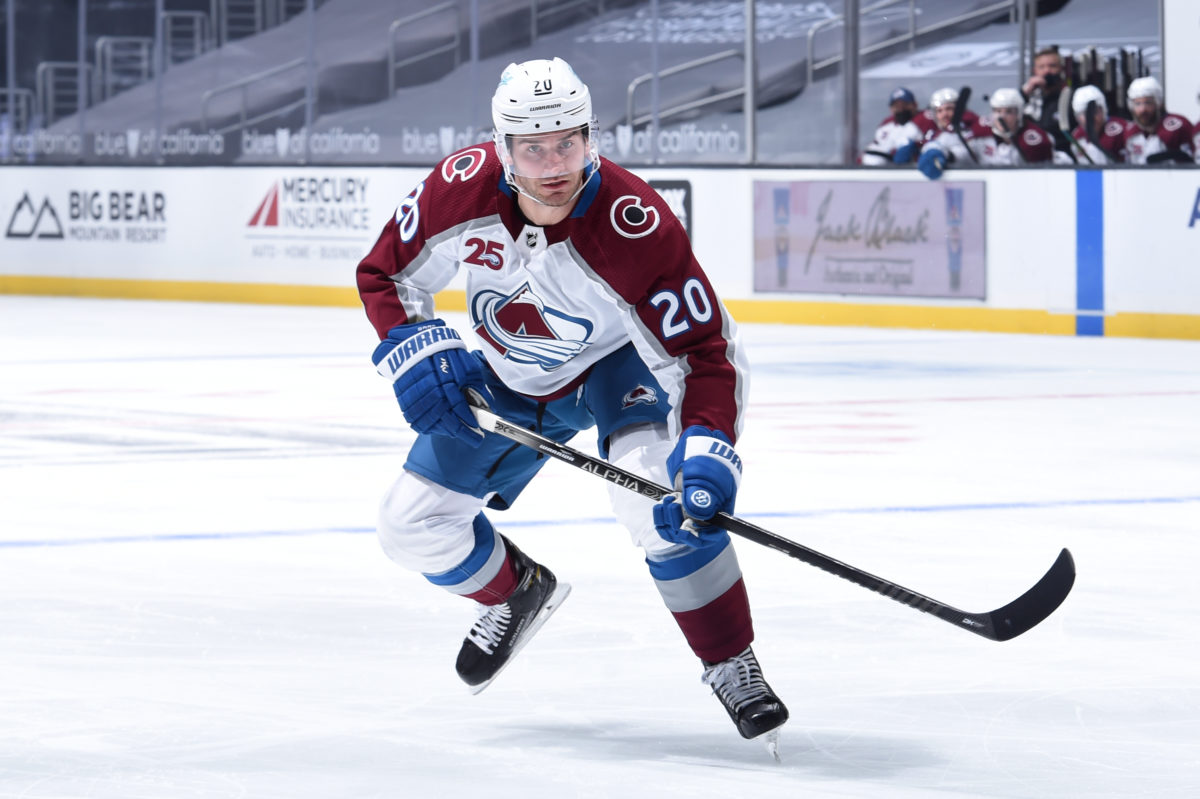As the unusual 2020-21 season has come and gone for the Chicago Blackhawks, our coverage team is taking a look back and handing out grades for the entire team. Today, we will grade the season of defenseman Nikita Zadorov, who certainly drove a lot of conversation throughout the course of the condensed, regular season.
Related – Chicago Blackhawks 2020-21 Player Grades
Zadorov was the subject of plenty of debates across social media, and his name came up often during or weekly installments of Blackhawks Banter. While he did provide a physical presence the team needed on the back end, he didn’t exactly improve the overall team defense either. Even now, there are still many fans who want him re-signed in Chicago and plenty who want him as far away from the Blackhawks’ blue line as possible.
Overall Season Stats
Standard: 55 games played (GP), 1 goal (G), 7 assists (A), plus-1, 36 penalty minutes (PIM), 52 shots on goal (S), 120 total shot attempts (TSA), 19:12 average time on ice (ATOI), 74 blocked shots, 190 hits, 16 takeaways, 41 giveaways

Advanced Metrics: 44.13 Corsi for percentage (CF%), 102.3 PDO, 50.21 goals for percentage (GF%), 45.62 expected goals for percentage (xGF%), 1.96 goals for per 60 mins (GF/60), 1.95 goals against per 60 (GA/60), 24.13 shots for per 60 mins (SF/60), 30.48 shots allowed per 60 mins (SA/60), 1.9 expected goals for per 60 mins (xGF/60), 2.26 expected goals against per 60 min (xGA/60), -0.1 goals against replacement (GAR), 0 wins against replacement (WAR), 0 standing points against replacement (SPAR)
Bringing the Hits
Zadorov became a member of the Blackhawks back on Oct. 12, 2020. He was acquired from the Colorado Avalanche, along with fellow defenseman Anton Lindholm, for Brandon Saad and Dennis Gilbert. The Blackhawks also retained $1 million of Saad’s $6 million salary.

This trade came shortly after general manager Stan Bowman penned a letter to fans that the team was entering a rebuilding period. Moving a player like Saad when rebuilding made all the sense in the world, but not for a 25-year-old defenseman. Ideally, a team looking to restock for the future should have acquired draft picks and/or prospects in a deal like this.
However, Bowman said a physical presence on the backend his team desperately needed and he pulled the trigger.
“Nikita is a defensive player; he’s not going to be leading the rush or trying to dive down and make a ton of offense that way. He’s a good passer, but he’s more skewed on the defensive side, so he would be a nice complement to the young guys we have.
“Last year, we saw Adam (Boqvist) take some hits, and I think teams target smaller guys to get them off their game. That’s something we want to make sure doesn’t happen going forward.”
From “The inside story of the Blackhawks’ Brandon Saad-for-Nikita Zadorov trade” by Ben Pope – Chicago Sun-Times 10/22-20
I was not too familiar with Zadorov’s overall game at the time of the trade, so I reached out to some colleagues who cover the Avalanche. The prevailing theme I got in the scouting reports was that he would supply some big hits but sacrifice his positioning to do it. We saw this quite a few times during the season. Sometimes the risk paid off with a highlight reel hit, and other times it led to the puck being put into his own net.
More Than Meets the Eye
Hits are not my favorite statistical category. First off, they are subjective and at the mercy of the official scorer at the home arena. Secondly, it’s a generic stat that doesn’t tell you anything about the context of a hit. Did it lead to a turnover or help establish a forecheck? Did you put your team shorthanded or get you out of position to throw it?
No matter what you think of hits as a stat, they are still a big part of the game, and Zadorov’s hit total jumps off the page. He led the team with 190 of them, 88 more than Connor Murphy, who was second. His total was good enough for the seventh-most in the NHL and fourth among all defensemen.
Since offense is not a major part of Zadorov’s game despite being a pretty good passer, let’s dive into the numbers to see how he is at preventing shots and goals against his goaltender. Even though he seemed to find himself out of position quite a bit, he surprisingly wasn’t too bad in these categories, at least compared to the defensemen on the team.
Out of the “regular defensemen,” only Ian Mitchell had a lower CF%. However, Zadorov’s 30.48 SA/60 were the third-best behind Murphy and Calvin De Haan. It may surprise you that his 1.95 GA/60 was by far the best among the defensemen at the end of the season. In fact, he was the only blueliner that had a GA/60 under 2. De Haan was the worst at 3.4, followed by Duncan Keith at 3.11. Among Blackhawks who played in at least 20 games, only Alex DeBrincat had a higher PDO (team’s shooting % + save % when a player is on the ice). So, when you look at the metrics, even though he spent more time on his end of the ice, he did a good job at preventing shots and goals against; the main job of an NHL defenseman.
Zadorov is a perfect example of a player who might fail the eye test, but the analytics prove otherwise. When you watch him chase a puck carrier above the faceoff dots to make a big hit while leaving the front of the net exposed, you want to rip your hair out of your head. However, the numbers show he was one of the best defensive defensemen on the team.
Bowman alluded to this in the Ben Pope interview last October, saying he could be a good partner for a young defenseman like Mitchell or Boqvist. That never turned out to be true. He spent the most time 5v5 with Murphy and put up his best numbers. When together, they had a combined 46.8 CF%. When paired with Mitchell, that number dropped to 39.22% and 38.74% when he skated with Nicolas Beaudin. He and Boqvist were never paired together at 5v5. The two forwards he spent the most 5v5 time on ice with were Patrick Kane and Debrincat, and we don’t need a rocket scientist to figure that out.
Overall Grade: C
If you watched Blackhawks Banter this season or follow me on Twitter, this grade probably surprises you. I was as critical as anyone of Zadorov, but as I did a deeper look at the metrics, I realized his play wasn’t as terrible as I first thought. However, Bowman needs to be careful going forward.
Zadorov is a restricted free agent this summer. There were rumblings at the trade deadline that Bowman was taking calls about a trade but ultimately decided against a move. He could still be traded during the offseason, but it sounds like re-signing is the most likely scenario.
Bowman should not bring back Zadorov on a long-term deal. Both his WAR and SPAR were zero this season. That means he is a “replacement-level” player. So, by these metrics, if you replaced him with your average AHL call-up or free agent, there would be no change in team wins or overall points. Hence, the final C grade.
Zadorov was brought in to add some toughness and physicality to the Blackhawks’ blue line, and he did deliver. Where you stand on advanced stats and numbers is going weigh into how you judged his overall performance during 2020-21.
If you are craving more Blackhawks content, be sure to check out our weekend Blackhawks Banter show. Subscribe to our YouTube Channel, like our Facebook Page, and follow us on Twitter to catch every new episode. You can also now listen to our show in podcast form on your preferred platform.
All stats courtesy of Evolving Hockey.